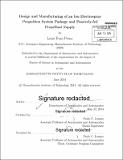Design and manufacturing of an ion electrospray propulsion system package and passively-fed propellant supply
Author(s)
Perna, Louis Evan
DownloadFull printable version (13.97Mb)
Other Contributors
Massachusetts Institute of Technology. Department of Aeronautics and Astronautics.
Advisor
Paulo C. Lozano.
Terms of use
Metadata
Show full item recordAbstract
Satellites under 500 kilograms have been growing more popular with the miniaturization of high-performance electronics and instruments. Constellations and formations of satellites consisting of thousands of small satellites will enable inexpensive, on-demand, global access to spaceborne assets. The only impediment to the adoption of small satellites and their exploitation in radical new space system architectures is an absence of high-specific-impulse, scalable, benign propulsion options. Available technologies are too resource inefficient for small satellites, too inflexible, or pose a threat to primary launch payloads. An emergent technology, electrospray propulsion, is inherently scalable, benign, applicable to a wide range of mission types, and resource efficient. Research in the MIT Space Propulsion Laboratory over the past decade has been focused on developing robust electrospray propulsion systems scaled to the needs of small spacecraft. The Ion Electrospray Propulsion System (iEPS) is the synthesis of this work and features a fully-integrated power processing unit (PPU), propellant supply, and electrostatic ion accelerator designed for use in CubeSats. To meet the objectives of the iEPS project, development was necessary for all three components. The work described here focused on a redesign of the thruster module package and initial design and testing of a compact, passive propellant supply system. A MEMS package was designed, manufactured, and tested. It comprised and contained critical electrospray components in close, precise proximity and maintained electrical isolation between high voltage electrodes. Additionally, the package provided for structural and electrical attachment interfaces for the PPU and propellant supply. Design rationale is presented and iterative improvements described for both the package components and manufacturing processes. A prototype passive propellant supply system was designed and tested. The results of integration and testing for both components are presented with discussion of challenges and potential improvements.
Description
Thesis: S.M., Massachusetts Institute of Technology, Department of Aeronautics and Astronautics, 2014. Cataloged from PDF version of thesis. Includes bibliographical references (pages 129-130).
Date issued
2014Department
Massachusetts Institute of Technology. Department of Aeronautics and AstronauticsPublisher
Massachusetts Institute of Technology
Keywords
Aeronautics and Astronautics.